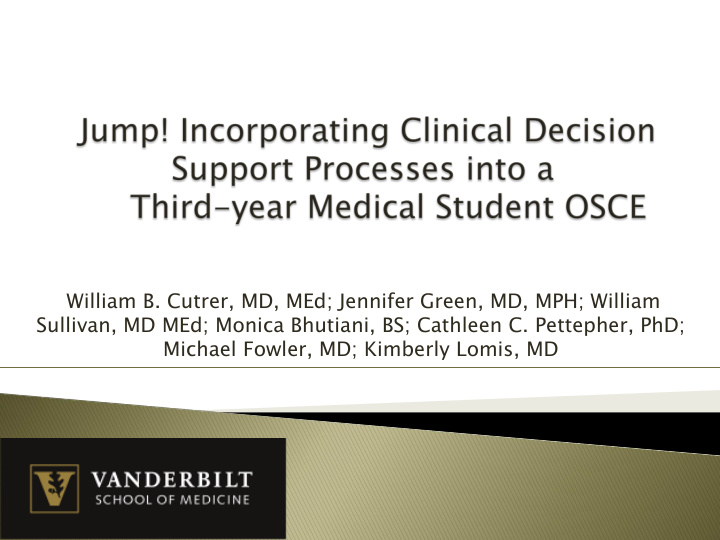



William B. Cutrer, MD, MEd; Jennifer Green, MD, MPH; William Sullivan, MD MEd; Monica Bhutiani, BS; Cathleen C. Pettepher, PhD; Michael Fowler, MD; Kimberly Lomis, MD
} I have no conflicts of interest to disclose
} Assessment drives learning } Objective Structured Clinical Examinations (OSCEs) are one of the most commonly used strategies to assess medical student clinical skills } OSCE evaluators assess medical student ◦ history-taking ◦ physical examination skills ◦ diagnostic reasoning Harden & Gleeson (1979) Medical Education Cox, Irby, Epstein (2007) NEJM
} In OSCE setting: ◦ Students are expected to use existing knowledge to make decisions ◦ Including decisions that practicing physicians often make with the support of external resources in the real clinical setting
} Evidence-Based Medicine (EBM) has stressed the cycle of Ask à à Search/Acquire à à Appraise à à Apply to allow practitioners to find appropriate answers to guide patient care Rosenberg & Donald (1995) BMJ Del Mar et al. (2004) BMJ
} Some OSCEs have begun to incorporate Evidence-Base Medicine Skills ◦ Used paper or computerized case scenarios ◦ Assess different components of the EBM process Questioning Searching Appraising Application Frohna et al. (2006) Teach Learn Med Fliegel et al. (2002) Acad Med Tudiver et al. (2009) Fam Med
Question: ¡ } Will access to external resources improve student knowledge and confidence in the formulation of clinical management plans in a standardized patient OSCE setting? ¡
} During the end of clerkship phase OSCE } Piloted a new exam component to assess student information retrieval and usage (EBM skills) } Referred to as a Triple Jump Examination (TJE ) ◦ Attempt a task independently (internal knowledge-based) ◦ Access external resources (can be formally assessed) ◦ Reattempt the task (cloud-enhanced performance)
} Our students independently: ◦ Assessed a standardized patient using history and physical examination ◦ Answered clinical questions regarding patient management Community-Acquired Pneumonia: What antibiotic regimen would you use for treatment? Musculoskeletal Back Pain: What is the appropriate next step in management?
C onfid ence Clinical Question & Clinical Confidence Questions Access to Community-Acquired Online Pneumonia Scenario Resources End of Clerkship Clinical OSCE Access to Musculoskeletal Online Back Pain Scenario Resources Clinical Clinical Questions Question & Confidence Confidence
Community ty-Acquired Pneumonia (n (n=52) =52) ¡ Knowledge ¡ Knowledge ¡ Con@idence ¡ Performance ¡ Performance ¡ ¡ ¡ (out ¡of ¡5 ¡points) ¡ (0-‑100 ¡points) ¡ (1-‑5 ¡scale) ¡ (Absolute ¡Score) ¡ (Standardized ¡Score) ¡ Pre-Cloud Access 1.64 1.64 33.0 33.0 2.69 2.69 Post-Cloud Access 4.39 4.39 87.8 87.8 4.48 4.48 p-values <0. <0.001 001 <0. <0.001 001 <0. <0.001 001
Resources uti tilized # w # who o (N=49 of (N=49 of 52) 52) ¡ uti tilized (%) ¡ UpToDate ¡ 47 (96) ¡ 17 (35) ¡ Guidelines (specifically IDSA, ATS, and/or AAFP) ¡
Results ts: Community ty-Acquired Pneumonia
Musculoskeleta tal Back Pain (n (n=53) =53) ¡ Knowledge ¡ Knowledge ¡ Con@idence ¡ Performance ¡ Performance ¡ ¡ ¡ (out ¡of ¡3 ¡points) ¡ (0-‑100 ¡points) ¡ (1-‑5 ¡scale) ¡ (Absolute ¡Score) ¡ (Standardized ¡Score) ¡ Pre-Cloud Access 1.06 1.06 35.3 35.3 3.79 3.79 Post-Cloud Access 1.47 1.47 49.0 49.0 4.21 4.21 p-values 0.026 0.026 0.026 0.026 0.002 0.002
Resources uti tilized # who uti tilized (N=47 of (N=47 of 53) 53) ¡ (%) (%) ¡ UpToDate ¡ 45 (96) ¡ Guidelines (specifically ACP 9 (19) ¡ and APS) ¡ Primary literature ¡ 3 (6) ¡ Internet Search Engine ¡ 10 (21) ¡
Results ts: Musculoskeleta tal Back Pain
} Pairing an assessment of student knowledge retrieval and application with a standardized patient OSCE is feasible } After accessing online resources, student scores showed: ◦ Improvement in knowledge and confidence around appropriate management of CAP ◦ Improvement in knowledge and confidence around appropriate management for MSK back pain
} Student choice of online resources: ◦ Majority of students used UpToDate ◦ Society-specific practice guidelines were the other major resource accessed ◦ Searching appears to be more efficient when students had a definitive diagnosis (CAP vs MSK back pain)
} Does student confidence in the OSCE answer impact the time and depth of their use of external resources? } We would like to consider several further analyses with our next assessments. ◦ Screen capture to analyze specific search strategies and processes for the students ◦ Analysis of time spent by students during the search for answers to the given patient care questions ◦ Examination of correlations between student confidence levels and time spent searching (Preliminary evaluation suggests that low level of confidence did not lead to longer search times)
Recommend
More recommend